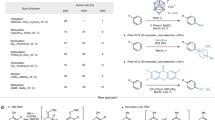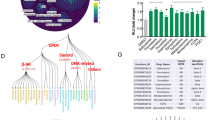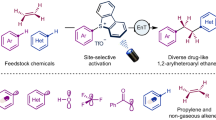Abstract
Aim:
To explore the function of the conserved aromatic cluster F2135.47, F3086.51, and F3096.52 in human β3 adrenergic receptor (hβ3AR).
Methods:
Point mutation technology was used to produce plasmid mutations of hβ3AR. HEK-293 cells were transiently co-transfected with the hβ3AR (wild-type or mutant) plasmids and luciferase reporter vector pCRE-luc. The expression levels of hβ3AR in the cells were determined by Western blot analysis. The constitutive signalling and the signalling induced by the β3AR selective agonist, BRL (BRL37344), were then evaluated. To further explore the interaction mechanism between BRL and β3AR, a three-dimensional complex model of β3AR and BRL was constructed by homology modelling and molecular docking.
Results:
For F3086.51, Ala and Leu substitution significantly decreased the constitutive activities of β3AR to approximately 10% of that for the wild-type receptor. However, both the potency and maximal efficacy were unchanged by Ala substitution. In the F3086.51L construct, the EC50 value manifested as a “right shift” of approximately two orders of magnitude with an increased Emax. Impressively, the molecular pharmacological phenotype was similar to the wild-type receptor for the introduction of Tyr at position 3086.51, though the EC50 value increased by approximately five-fold for the mutant. For F3096.52, the constitutive signalling for both F3096.52A and F3096.52L constructs were strongly impaired. In the F3096.52A construct, BRL-stimulated signalling showed a normal Emax but reduced potency. Leu substitution of F3096.52 reduced both the Emax and potency. When F3096.52 was mutated to Tyr, the constitutive activity was decreased approximately three-fold, and BRL-stimulated signalling was significantly impaired. Furthermore, the double mutant (F3086.51A_F3096.52A) caused the total loss of β3AR function. The predicted binding mode between β3AR and BRL revealed that both F3086.51 and F3096.52 were in the BRL binding pocket of β3AR, while F2135.47 and W3056.48 were distant from the binding site.
Conclusion:
These results revealed that aromatic residues, especially F3086.51 and F3096.52, play essential roles in the function of β3AR. Aromatic residues maintained the receptor in a partially activated state and significantly contributed to ligand binding. The results supported the common hypothesis that the aromatic cluster F[Y]5.47/F[Y]6.52/F[Y]6.51 conserved in class A G protein-coupled receptor (GPCR) plays an important role in the structural stability and activation of GPCRs.
Similar content being viewed by others
Log in or create a free account to read this content
Gain free access to this article, as well as selected content from this journal and more on nature.com
or
References
Kenakin T . Agonist-receptor efficacy I: mechanisms of efficacy and receptor promiscuity. Trends Pharmacol Sci 1995; 16: 188–92.
Lefkowitz RJ, Cotecchia S, Samama P, Costa T . Constitutive activity of receptors coupled to guanine nucleotide regulatory proteins. Trends Pharmacol Sci 1993; 14: 303–7.
Schwartz TW, Frimurer TM, Holst B, Rosenkilde MM, Elling CE . Molecular mechanism of 7TM receptor activation — a global toggle switch model. Annu Rev Pharmacol Toxicol 2006; 46: 481–519.
Schwartz TW, Rosenkilde MM . Is there a 'lock' for all agonist 'keys' in 7TM receptors? Trends Pharmacol Sci 1996; 17: 213–6.
Gether U, Lin S, Ghanouni P, Ballesteros JA, Weinstein H, Kobilka BK . Agonists induce conformational changes in transmembrane domains III and VI of the beta2 adrenoceptor. EMBO J 1997; 16: 6737–47.
Gether U, Lin S, Kobilka BK . Fluorescent labeling of purified beta 2 adrenergic receptor. Evidence for ligand-specific conformational changes. J Biol Chem 1995; 270: 28268–75.
Sheikh SP, Zvyaga TA, Lichtarge O, Sakmar TP, Bourne HR . Rhodopsin activation blocked by metal-ion-binding sites linking transmembrane helices C and F. Nature 1996; 383: 347–50.
Ghanouni P, Steenhuis JJ, Farrens DL, Kobilka BK . Agonist-induced conformational changes in the G-protein-coupling domain of the beta 2 adrenergic receptor. Proc Natl Acad Sci U S A 2001; 98: 5997–6002.
Elling CE, Frimurer TM, Gerlach LO, Jorgensen R, Holst B, Schwartz TW . Metal ion site engineering indicates a global toggle switch model for seven-transmembrane receptor activation. J Biol Chem 2006; 281: 17337–46.
Vogel R, Mahalingam M, Ludeke S, Huber T, Siebert F, Sakmar TP . Functional role of the “ionic lock” — an interhelical hydrogen-bond network in family A heptahelical receptors. J Mol Biol 2008; 380: 648–55.
Rasmussen SG, Jensen AD, Liapakis G, Ghanouni P, Javitch JA, Gether U . Mutation of a highly conserved aspartic acid in the beta2 adrenergic receptor: constitutive activation, structural instability, and conformational rearrangement of transmembrane segment 6. Mol Pharmacol 1999; 56: 175–84.
Li J, Edwards PC, Burghammer M, Villa C, Schertler GF . Structure of bovine rhodopsin in a trigonal crystal form. J Mol Biol 2004; 343: 1409–38.
Okada T, Sugihara M, Bondar A-N, Elstner M, Entel P, Buss V . The retinal conformation and its environment in rhodopsin in light of a new 2.2Å crystal structure. J Mol Biol 2004; 342: 571–83.
Warne T, Serrano-Vega MJ, Baker JG, Moukhametzianov R, Edwards PC, Henderson R, et al. Structure of a beta1-adrenergic G-protein-coupled receptor. Nature 2008; 454: 486–91.
Jaakola VP, Griffith MT, Hanson MA, Cherezov V, Chien EY, Lane JR, et al. The 2.6 angstrom crystal structure of a human A2A adenosine receptor bound to an antagonist. Science 2008; 322: 1211–7.
Visiers I, Ballesteros JA, Weinstein H . Three-dimensional representations of G protein-coupled receptor structures and mechanisms. Methods Enzymol 2002; 343: 329–71.
Klein-Seetharaman J, Yanamala NV, Javeed F, Reeves PJ, Getmanova EV, Loewen MC, et al. Differential dynamics in the G protein-coupled receptor rhodopsin revealed by solution NMR. Proc Natl Acad Sci U S A 2004; 101: 3409–13.
Crocker E, Eilers M, Ahuja S, Hornak V, Hirshfeld A, Sheves M, et al. Location of Trp265 in metarhodopsin II: implications for the activation mechanism of the visual receptor rhodopsin. J Mol Biol 2006; 357: 163–72.
Shi L, Liapakis G, Xu R, Guarnieri F, Ballesteros JA, Javitch JA . Beta2 adrenergic receptor activation. Modulation of the proline kink in transmembrane 6 by a rotamer toggle switch. J Biol Chem 2002; 277: 40989–96.
Cherezov V, Rosenbaum DM, Hanson MA, Rasmussen SG, Thian FS, Kobilka TS, et al. High-resolution crystal structure of an engineered human beta2-adrenergic G protein-coupled receptor. Science 2007; 318: 1258–65.
Emorine LJ, Marullo S, Briend-Sutren MM, Patey G, Tate K, Delavier-Klutchko C, et al. Molecular characterization of the human beta 3-adrenergic receptor. Science 1989; 245: 1118–21.
Yamazaki Y, Takeda H, Akahane M, Igawa Y, Nishizawa O, Ajisawa Y . Species differences in the distribution of beta-adrenoceptor subtypes in bladder smooth muscle. Br J Pharmacol 1998; 124: 593–9.
Fujimura T, Tamura K, Tsutsumi T, Yamamoto T, Nakamura K, Koibuchi Y, et al. Expression and possible functional role of the beta3-adrenoceptor in human and rat detrusor muscle. J Urol 1999; 161: 680–5.
Lenard NR, Gettys TW, Dunn AJ . Activation of beta2- and beta3-adrenergic receptors increases brain tryptophan. J Pharmacol Exp Ther 2003; 305: 653–9.
Claustre Y, Leonetti M, Santucci V, Bougault I, Desvignes C, Rouquier L, et al. Effects of the beta3-adrenoceptor (Adrb3) agonist SR58611A (amibegron) on serotonergic and noradrenergic transmission in the rodent: relevance to its antidepressant/anxiolytic-like profile. Neuroscience 2008; 156: 353–64.
Accelrys. InsightII, Version 2005, Molecular modeling package. San Diego, CA: Molecular Simulation, Accelrys; 2005.
Rasmussen SG, Choi HJ, Fung JJ, Pardon E, Casarosa P, Chae PS, et al. Structure of a nanobody-stabilized active state of the beta(2) adrenoceptor. Nature 2011; 469: 175–80.
Laskowski RA, Macarthur MW, Moss DS, Thornton JM . Procheck — a program to check the stereochemical quality of protein structures. J Appl Crystallogr 1993; 26: 283–91.
Morris GM, Goodsell DS, Halliday RS, Huey R, Hart WE, Belew RK, et al. Automated docking using a Lamarckian genetic algorithm and an empirical binding free energy function. J Comput Chem 1998; 19: 1639–62.
Holst B, Nygaard R, Valentin-Hansen L, Bach A, Engelstoft MS, Petersen PS, et al. A conserved aromatic lock for the tryptophan rotameric switch in TM-VI of seven-transmembrane receptors. J Biol Chem 2010; 285: 3973–85.
Strader CD, Candelore MR, Hill WS, Dixon RA, Sigal IS . A single amino acid substitution in the beta-adrenergic receptor promotes partial agonist activity from antagonists. J Biol Chem 1989; 264: 16470–7.
Wong SK, Slaughter C, Ruoho AE, Ross EM . The catecholamine binding site of the beta-adrenergic receptor is formed by juxtaposed membrane-spanning domains. J Biol Chem 1988; 263: 7925–8.
Strader CD, Candelore MR, Hill WS, Sigal IS, Dixon RA . Identification of two serine residues involved in agonist activation of the beta-adrenergic receptor. J Biol Chem 1989; 264: 13572–8.
Takayuki S, Hiroyuki K, Taku N, Hitoshi K . Ser203 as well as Ser204 and Ser207 in fifth transmembrane domain of the human β2-adrenoceptor contributes to agonist binding and receptor activation. Br J Pharmacol 1999; 128: 272–4.
Wieland K, Zuurmond HM, Krasel C, Ijzerman AP, Lohse MJ . Involvement of Asn-293 in stereospecific agonist recognition and in activation of the β2-adrenergic receptor. Proc Natl Acad Sci U S A 1996; 93: 9276–81.
Jin F, Lu C, Sun X, Li W, Liu G, Tang Y . Insights into the binding modes of human beta-adrenergic receptor agonists with ligand-based and receptor-based methods. Mol Divers 2011; 15: 817–31.
Acknowledgements
This work was supported by grants from the National Natural Science Foundation of China (20721003, 81072681), the International S&T Cooperation(2010DFB73280), and the Shanghai Committee of Science and Technology International Cooperation Project (09540703900).
Author information
Authors and Affiliations
Corresponding authors
Additional information
Supplementary figures are available at website of Acta Pharmacologica Sinica on NPG.
Supplementary information
Supplementary information, Figure S1
Expression levels of beta3AR mutants determined by Western bolt. (DOC 879 kb)
Supplementary information, Figure S2
Ramachandran plot for analyzing the rationality of beta3AR structure (DOC 230 kb)
Supplementary information, Figure S3
Cell lines comparison. (DOC 53 kb)
Supplementary information, Table S1
The amino acid distribution in position of 5.47, 6.51 and 6.52 in the Rhodopsin receptor family (class A) (DOC 38 kb)
Rights and permissions
About this article
Cite this article
Cai, Hy., Xu, Zj., Tang, J. et al. The essential role for aromatic cluster in the β3 adrenergic receptor. Acta Pharmacol Sin 33, 1062–1068 (2012). https://doi.org/10.1038/aps.2012.55
Received:
Accepted:
Published:
Issue date:
DOI: https://doi.org/10.1038/aps.2012.55
Keywords
This article is cited by
-
β3-adrenergic receptor activity modulates melanoma cell proliferation and survival through nitric oxide signaling
Naunyn-Schmiedeberg's Archives of Pharmacology (2014)
-
Functional involvement of β3-adrenergic receptors in melanoma growth and vascularization
Journal of Molecular Medicine (2013)



